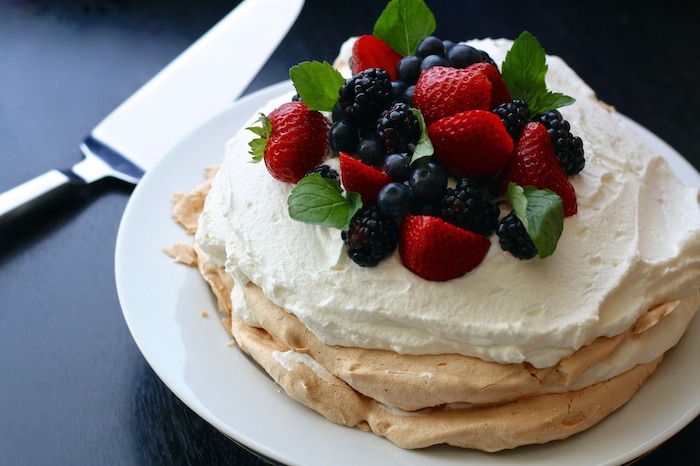No, France, this is not pavlova
Pavlova has always been a contentious subject for us ‘Antipodeans’. Us Australians say we created it. New Zealanders say the same. It all started when famous Russian ballerina, Anna Pavlova, visited both countries during the 1920s. Pavlovas, or ‘pavs’ as they’re more commonly referred to in their country(s) of origin, started being produced in both countries as birthday cakes, BBQ desserts and basically any other celebration. “I’ll just whip up a pav” was something heard frequently at home, when invited over to a friend’s place for a gathering. I was shocked when I first discovered that Kiwis wanted to claim it as their dessert, and I’m sure every Kiwi was shocked to hear the same about Australians.
As contentious as its creation is, Kiwis and Aussies do agree on the general construction of a pav. Crusty and delicately browned on the outside and gooey and soft inside, a bit like tender marshmallow. That’s the whole point of pav. Top it with cream, then some fruit — favourites at home were strawberries or kiwi fruit (that doesn’t mean it’s from New Zealand though) — and maybe some mint leaves, and Bob’s your uncle: it’s ready. Sometimes, we got fancy and decadent, crushing up Peppermint Crisp chocolate bars as a fruit substitute. Regardless, the humble pav always featured a gooey centre and an ever-so lightly-browned crust. Here’s one such example of the perfect pav:

One of the benefits of pavlova is that the gooey centre liquefies after the first day or so, which means it really should be eaten on the day it’s made. What a hardship we faced, growing up in Australia, having to finish off a delicious sugary treat (but with fruit, so still classed as healthy) after our last dip in the pool on a balmy warm evening with friends. Yes, pav rekindles fond childhood memories for me — something I appreciate even more now that I’m living away from home.
So you can imagine my utter shock when French recipes started appearing as ‘sponsored posts’ on Facebook, showing how to make pavlova, when there was no gooey centre at all. I started writing messages in French, like “C’est pas un vrai pavlova” (“It’s not a real pavlova”) and explaining what was required to make a real one. Nobody replied. I’m sure they just thought “C’est qui, cette anglaise?” (“Who is this English woman?”), and carried on with making the Frenchified pav.
This morning, I awoke to yet another recipe. This time, it’s pavlova revisited. Oh no it damn well is not! No. Noooooo. Mais NON. Here it is:
So, what we’re looking at here is a glorified meringue recipe. There’s nothing difficult or Australian (or Kiwi) about meringue — not even its name. Did anyone called Madame Meringue come to Australia in the twenties and wow the socks off so many people that chefs got creative and made dried bits of egg? No. Nope, meringue and Australia don’t even begin to rub shoulders in the same circles. Pavlova is a different beast entirely.
Having said that, the dessert above does look delicious, but please France, understand it’s meringue and not pavlova.
 Copyright protected by Digiprove
Copyright protected by Digiprove
.. came across your interesting blog whilst researching coucougnettes. On the subject of pavlovas, you may not want to look at the Wikipedia entry, which asserts that “Later research by Andrew Wood and Annabelle Utrecht suggests the dessert originated in the United States and was based on an earlier Austrian dish.” There is a link to the Austrian dish, which is meringue based.. what a minefield!
The horror! Still, that Austrian dish has no fresh fruit, so even though the pav’s origins might be in this dessert, I’m still claiming Antipodean rights on the pav recipe front! Glad to hear you’re enjoying my blog. It’s been on the backburner lately. I think everything in France seemed odd as an outsider is starting to feel normal. I need to move countries!